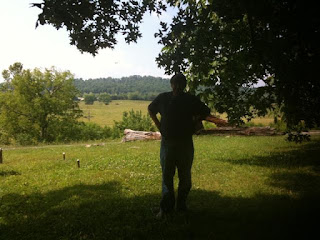from the Pontotoc Sentinel:
Mrs. Cory A. Bowen, wife of Walter Bowen, passed quietly away at their home three miles north of town Sunday morning, March 14, at 10:10 o'clock. She was an invalid for nineteen years but bore her afflictions patiently, at all times trusting in the Lord for help. On April 25, 1913, she underwent a serious operation at the Baptist hospital, Memphis, returning there the following January for treatment which proved somewhat beneficial, but did not result in complete restoration. However, she was grateful for the partial relief and rejoiced in her improved condition and was the sunshine of the home she so much loved.
Her last illness was of a month's duration when she received the tenderest ministrations of husband, children and physician and the skilled nursing of a daughter-in-law, Mrs. Victor Bowen. The patient sufferer expressed appreciation of all the kind attention shown her, the visits and solicitous inquiries of friends concerning her health. She talked often of death during her illness and assured her loved ones she was prepared and ready to go when the Lord should call her. Perfectly conscious to the last she told those around her that she was dying, offered a beautiful prayer, tenderly bade her devoted husband good bye and gently fell asleep.
The funeral was held Monday noon at Oak Hill church which was filled with sorrowing relatives and friends. Rev. Henry West conducted the service in a feeling way, making a telling example of the life and patience of Jobe - how he endured to the end and was saved. Interment followed in the cemetery close by. She was laid near a little daughter Lillie, who, at the age of twenty-two months, died in the year 1906. Lovely spring flowers were laid on the newly made mound by those who loved the sleeper.
The deceased, a daughter of the late L. R. Wilder, was born Feb. 11, 1874, in Pontotoc County, near Bethel church, and had just passed her forty-first birthday. She professed faith in Christ at the age of twelve years and united with the Baptist church at Cherry Creek, but afterwards transferred her membership to Oak Hill. She loved church worship and the family alter was another sacred place always dear to her heart.
Corry Wilder was married to Walter H. Bowen Feb. 18, 1892, and to this happy and congenial couple were born five children, four of whom are living, Victor, Drue, Mary and Edd, and a daughter-in-law, Lizzie Lavona, who constitute the household now so sadly bereft by the absence of its most cherished member. To them and other relatives, THE SENTINEL extends sincere condolence.
Published: The Sentinel, Pontotoc, Mississippi March 25, 1915
Mrs. Cory A. Bowen, wife of Walter Bowen, passed quietly away at their home three miles north of town Sunday morning, March 14, at 10:10 o'clock. She was an invalid for nineteen years but bore her afflictions patiently, at all times trusting in the Lord for help. On April 25, 1913, she underwent a serious operation at the Baptist hospital, Memphis, returning there the following January for treatment which proved somewhat beneficial, but did not result in complete restoration. However, she was grateful for the partial relief and rejoiced in her improved condition and was the sunshine of the home she so much loved.
Her last illness was of a month's duration when she received the tenderest ministrations of husband, children and physician and the skilled nursing of a daughter-in-law, Mrs. Victor Bowen. The patient sufferer expressed appreciation of all the kind attention shown her, the visits and solicitous inquiries of friends concerning her health. She talked often of death during her illness and assured her loved ones she was prepared and ready to go when the Lord should call her. Perfectly conscious to the last she told those around her that she was dying, offered a beautiful prayer, tenderly bade her devoted husband good bye and gently fell asleep.
The funeral was held Monday noon at Oak Hill church which was filled with sorrowing relatives and friends. Rev. Henry West conducted the service in a feeling way, making a telling example of the life and patience of Jobe - how he endured to the end and was saved. Interment followed in the cemetery close by. She was laid near a little daughter Lillie, who, at the age of twenty-two months, died in the year 1906. Lovely spring flowers were laid on the newly made mound by those who loved the sleeper.
The deceased, a daughter of the late L. R. Wilder, was born Feb. 11, 1874, in Pontotoc County, near Bethel church, and had just passed her forty-first birthday. She professed faith in Christ at the age of twelve years and united with the Baptist church at Cherry Creek, but afterwards transferred her membership to Oak Hill. She loved church worship and the family alter was another sacred place always dear to her heart.
Corry Wilder was married to Walter H. Bowen Feb. 18, 1892, and to this happy and congenial couple were born five children, four of whom are living, Victor, Drue, Mary and Edd, and a daughter-in-law, Lizzie Lavona, who constitute the household now so sadly bereft by the absence of its most cherished member. To them and other relatives, THE SENTINEL extends sincere condolence.
Published: The Sentinel, Pontotoc, Mississippi March 25, 1915
Source: Pontotoc County Pioneers, Winter 1981 issue
Itawamba connection: Cora's husband, Walter, was the first cousin of Amanda Bowen Johnson, wife of John Norman "Jack" Johnson of the Mud Creek community of Itawamba County. Walter's father, Thomas Lake Bowen, and Amanda's father, William Elisha Bowen, were brothers. Although William Elisha moved to Itawamba County following the Civil War, pretty much the rest of his family stayed in Pontotoc County. Cora Wilder Bowen was the daughter of Leander and Elizabeth Wilder.
















































